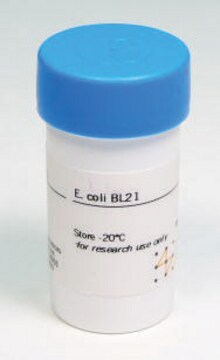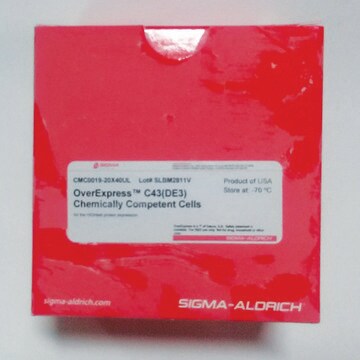CMC0016
BL21(DE3) Electrocompetent Cells
Escherichia coli, rod shaped
Synonym(s):
BL21 strain
About This Item
Recommended Products
product name
BL21(DE3) Electrocompetent Cells, for protein expression
biological source
Escherichia coli
grade
for molecular biology
growth mode
adherent or suspension
morphology
rod shaped
technique(s)
microbiological culture: suitable
cell transformation
competent cell type: electrocompetent
transformation efficiency: ≥5 × 109 cfu/μg
shipped in
dry ice
storage temp.
−70°C
General description
Cloning efficiencies are increased 25-1,000 fold relative to other preparations of BL21 cells, which is essential for construction of complex expression libraries.
Genotype
F – ompT hsdSB (rB- mB-) gal dcm (DE3)
Features and Benefits
Components
- BL21(DE3) electrocompetent cells
- pUC 19 transformation control DNA
- recovery medium for expression
Related product
Storage Class
10 - Combustible liquids
Certificates of Analysis (COA)
Search for Certificates of Analysis (COA) by entering the products Lot/Batch Number. Lot and Batch Numbers can be found on a product’s label following the words ‘Lot’ or ‘Batch’.
Already Own This Product?
Find documentation for the products that you have recently purchased in the Document Library.
Articles
Bacterial transformation is a process of horizontal gene transfer by which some bacteria take up foreign genetic material (naked DNA) from the environment. Bacteria that can take up free, extracellular genetic material are known as competent cells.
Protocols
BL21(DE3) Electrocompetent Cells are provided in 25 μL aliquots, sufficient for one reaction. Transformation is carried out in a 0.1 cm gap cuvette. Optimal settings for electroporation are listed in the table below. Note that alternate settings result in transformation efficienes about 20-50% lower. Typical time constants are 3.5 to 4.5 msec.
Our team of scientists has experience in all areas of research including Life Science, Material Science, Chemical Synthesis, Chromatography, Analytical and many others.
Contact Technical Service





